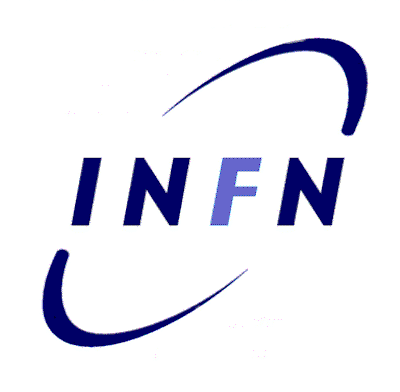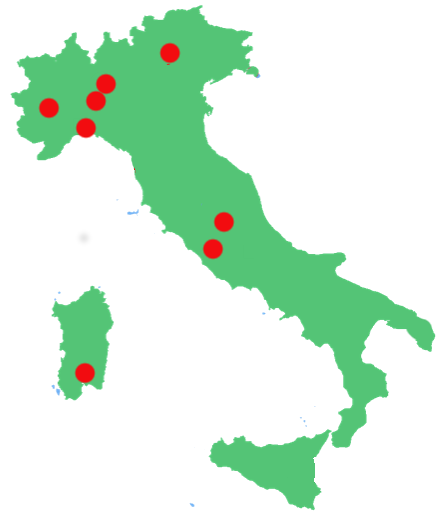Scientific activities of the various Research Units
Cagliari
The activity of the Cagliari node has been recently devoted to the following main topics:- an updated extraction of the quark transversity distribution and the Collins fragmentation function from recent SIDIS and e+e-collision data;
- a new study of the potential contribution of the Sivers and Collins effects to the transverse single spin asymmetry in polarized p p → h X processes at large Feynman x;
- study of the process dependence of the Sivers and Collins effects in polarized p p → jet pion X processes;
- study of transverse single spin asymmetries and TMD factorization in lepton-proton → pion + X processes;
- study of TMD evolution and non-perturbative effects in transverse momentum spectra of Z-boson production in Drell-Yan.
Genova
The activity of the Genova node is focussed on:- using locally constructed quark models that already reproduce form factors of nucleon and its resonances, improve the 3-quark baryon and 2-quark meson wave functions by including higher Fock components (meson cloud); test these wave functions by calculating nucleon TMDs and by exploring the spectrum of meson hybrids and the nature of X,Y resonances;
- give theoretical support to the new HASPECT project, started in the context of the INFN experimental program at CLAS12 (Jefferson Lab, Virginia - USA), in order to create an analysis center for investigating exotic bound states in the meson spectrum.
Milano Bicocca
The node in Milano Bicocca is working on an attempt to build a unified theoretical picture for single-spin asymmetries with transversely polarized beams and targets, putting special emphasis on the Drell-Yan processes at large longitudinal momentum, where a delicate interplay occurs between the transverse momentum dependence of TMDs and higher-twist contributions from multi-parton mechanisms.Pavia
The Pavia node will continue to work on the following topics:- including sea quarks in the Light-Cone wave function representation of the Fock space expansion of hadron states to explore TMD and GPD properties;
- studying the problem of the quark Orbital Angular Momentum (OAM);
- mapping of the full flavor and momentum dependence of (un)polarized TMDs and fragmentations, using SIDIS multiplicities and spin asymmetry data and including effects from TMD evolution; improving the extraction of the Sivers TMD and its relation to the GPD E in order to better quantify the quark OAM;
- improving the extraction of transversity for valence and sea quarks using the technique of di-hadron semi-inclusive production in various hard processes.
Perugia
The activity of the Perugia unit is devoted to two main issues. The first one is the study of high energy electron scattering off light nuclei, 3He in particular, in collaboration with the Roma 1 node, to obtain a flavor decomposition of relevant parton observables (TMDs for example) and support theoretically the experimental activity, in particular at Jefferson Lab (Virginia-USA). The other one is to study the 3-dimensional nucleon structure by means of relativistic model calculations. Recently, relevant results (in collaboration with the Trento node) have been obtained for the double distribution functions, which are crucial tools for the analysis of double parton scattering and the search of New Physics at LHC.Roma 1
The activity of the Roma1 node is developing along the following lines:- in a fully covariant constituent model of the quark-pion vertex, study the pion unpolarized and tensor GPDs and TMDs;
- in collaboration with the Perugia node on its first listed topic, explore the valence contribution to various parton quantities (TMDs, GPDs) in the nucleon by using high-energy electron scattering off light nuclei;
- solve the ladder and cross-ladder Bethe-Saltpeter equation in Minkowski space to study the excitation spectrum of a two-body system in order to extract its valence distributions, specifically on the Light Cone.
Torino
The Torino node will continue the combined analysis of unpolarized cross sections in Semi-Inclusive DIS (SIDIS), Drell-Yan, and e+e- processes, aiming at a global fit based on TMDs, taking into account their evolution effects. An improved study of the transverse kinematics in the azimuthal correlations of pairs of hadron produced in opposite jets in e+e- processes will help in the extraction of the Collins fragmentation functions and, consequently, of the transversity distributions. The analysis of azimuthal SIDIS asymmetries in order to extract the Collins and Boer-Mulders functions, also including TMD evolution effects and exploring various model dependences on intrinsic transverse momentum of partons, is in progress.TIFPA - Trento
The activity of the Trento node is focused on two well identified topics:- study of charge and isospin symmetry violations using meson cloud models and light-cone quark wave functions, including QCD perturbative evolution at NNLO and charge symmetry violating QED effects;
- combining thermal and non-equlibrium quantum field theory formalism with numerical stochastic algorithms, the real-time dynamics has been investigated for heavy quarks propagating off thermal equilibrium. In particular, the problem of characterizing the formation and recombination of bound-states above the deconfinement phase transition has been considered. The role of topological gauge field fluctuations above the deconfinement temperature has also been explored.
^ Back to Top


